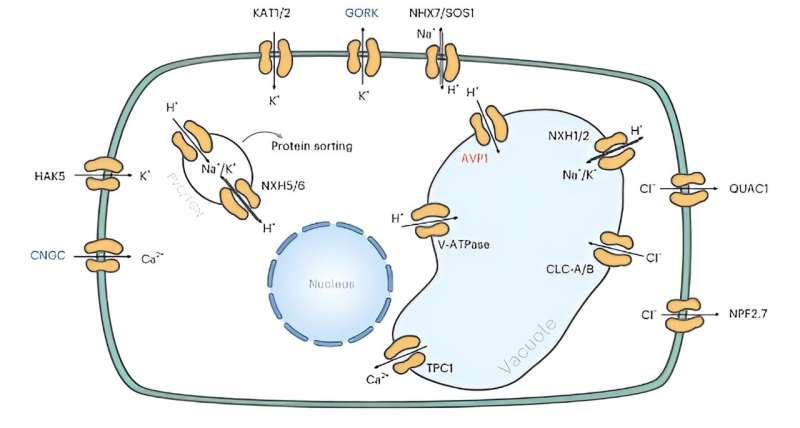This article has been reviewed according to Science X's editorial process and policies. Editors have highlighted the following attributes while ensuring the content's credibility:
fact-checked
peer-reviewed publication
trusted source
proofread
Genomic analysis sheds light on how seagrasses conquered the sea

Seagrasses provide the foundation of one of the most highly biodiverse, yet vulnerable, coastal marine ecosystems globally. They arose in three independent lineages from their freshwater ancestors some 100 million years ago and are the only fully submerged, marine flowering plants.
Moving to such a radically different environment is a rare evolutionary event and definitely not easy. How did seagrasses do it? New reference quality genomes provide important clues with relevance to their conservation and biotechnological application.
An international group of 38 researchers coordinated by Professor Dr. Yves Van de Peer, Ghent University, Belgium, Professor Dr. Jeanine Olsen, University of Groningen, Netherlands, Professor Dr. Thorsten Reusch, GEOMAR Helmholtz Center for Ocean Research Kiel, Germany, Dr. Gabriele Procaccini, Stazione Zoologica Anton Dohrn of Napoli, Italy, and the Joint Genome Institute, Berkeley, California, United States of America, sequenced and analyzed the genomes of three of the most important seagrass species—the iconic Mediterranean endemic Neptune grass (Posidonia oceanica), the broadly distributed Little Neptune grass (Cymodocea nodosa) and the Caribbean endemic Turtlegrass (Thalassia testudinum).
The researchers first examined genome structure and then compared gene families and pathways associated with structural and physiological adaptations, between the seagrasses and their related freshwater relatives. Their findings are presented in the journal Nature Plants, entitled "Seagrass genomes reveal ancient polyploidy and adaptations to the marine environment."
Seagrass-based ecosystems provide multiple functions and services—for instance as protection against erosion that preserves coastal seascapes, as biodiversity hotspots for associated animals and algae and as a nature-based solution for climate mitigation due to their carbon storage capacity in belowground biomass. Both conservation and restoration are areas of intensive research because seagrasses are being lost, as are coral reefs, to climate warming and other human impacts.
As the saying goes, "Many hands/brains make the work light." To begin, the research consortium took a deep evolutionary look at the structure of the genomes themselves, followed by a comparative analysis of their more than 20,000 genes and relevant pathways that have evolved into the specific marine adaptations.
Next, the 23 collaborating research teams each focused on different complementary structural or functional gene sets including their physiological functions. A key question was whether genomic adaptations came about in parallel, or whether they arose independently and maybe even involved different gene sets.
Professor Dr. Olsen points out, "Seagrasses underwent an extremely rare set of adaptations. Whereas re-adaptation to freshwater environments has occurred more than 200 times in flowering plant evolutionary history—involving hundreds of lineages and thousands of species—seagrasses evolved from their freshwater ancestors only three times—involving 84 species.
"To do this required specialized ecological tolerance to, for example, high salinity, lower light, a wide range of temperature tolerances, underwater carbon capture for photosynthesis, different pathogen defense, structural flexibility and an underwater pollination."
One major result was that seagrasses were able to jump-start radical adaptation via genome duplication, which is often associated with severe environmental stress.
"Comparison of the three independent seagrass lineages, including freshwater sister lineages, revealed a shared ancient whole genome triplication at about 86 million years. This was quite exciting because large parts of the ocean were oxygen-free at that time and it's also a uniting event involving the three lineages," says Professor Dr. Van De Peer.
Further, the researchers found that the retention and expansions of some gene families could still be traced back through retained syntenic blocks to these early duplication events, for example flavonoids to provide protection against ultraviolet radiation and fungi, while stimulating recruitment of nitrogen-fixing bacteria; expanded cysteine oxidases for coping with hypoxic sediments and genes associated with circadian clocks.
The results also showed that "jumping genes"—transposable elements—played a major role in creating new genetic variation for selection to act upon. This applied particularly to the large genomes of Thalassia testudinum and Posidonia oceanica.
The team also found several adaptations to be the result of convergence. This applied mainly to traits that became redundant or detrimental in a submerged, highly saline, marine environment. Loss of genes for stomata—the tiny holes in the leaf surface providing gas exchange with the atmosphere—loss of genes for volatiles and signaling to defend against pathogens and tolerate marine heat waves, notably heat shock factors, are compelling examples of "use it or lose it."
Dr. Procaccini explains, "It's clear that fine-tuning of supportive pathways has played the dominant role, rather than genes taking on major new functions. Salt-tolerance is a good example in which a higher efficiency of multiple processes has occurred to regulate sodium, chlorine and potassium. Evolutionary changes have also provided different species with the ability to withstand different environments."
Professor Dr. Reusch summarizes, "Most ecologically important functions are complex traits, involving the interaction of many genes through flexible pathways. With genomic tools now developed for key seagrasses, we can begin to experimentally test and manipulate them. This is especially important for restoration under climate change scenarios involving many of the conditions discussed here."
The new genomic resources will accelerate experimental and functional studies that are especially relevant to transformative management and restoration of seagrass ecosystems. They are a formidable resource for the research community.
More information: Xiao Ma et al, Seagrass genomes reveal ancient polyploidy and adaptations to the marine environment, Nature Plants (2024). DOI: 10.1038/s41477-023-01608-5
Journal information: Nature Plants
Provided by Helmholtz Association of German Research Centres




















